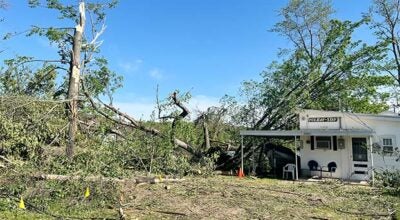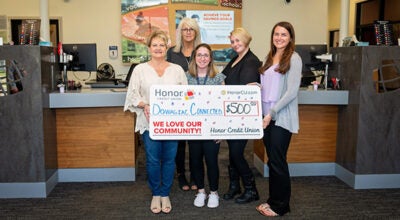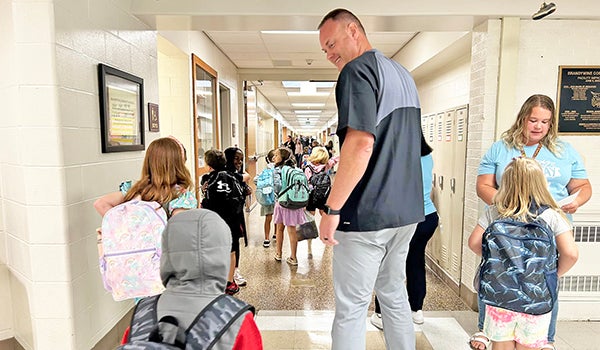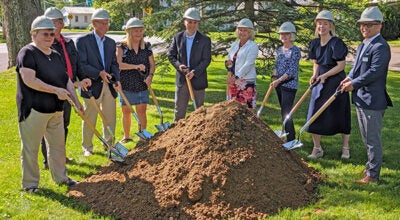Lakeland operates sleep labs in Niles, St. Joseph
Published 9:35 am Monday, October 12, 2009

Dr. Inga Sriubiene and manager James Hightower Oct. 9 in one of the three fifth-floor bedrooms of the Lakeland Sleep Disorder and Treatment Center at Lakeland Regional Medical Center, St. Joseph. It opened last December and is adding a fourth bed. There is also a two-bed sleep lab at Lakeland Community Hospital, Niles, which opened in 2003. (The Daily News/John Eby)
By JOHN EBY
Dowagiac Daily News
ST. JOSEPH – Snoring isn’t funny anymore.
Nor is a saying such as “you snooze, you lose” relevant thanks to refinements in sleep treatment.
Today, you lose if you don’t snooze.
Sleep apnea has been linked to such health maladies as hypertension, Type II diabetes, stroke, heart attacks, depression, memory concentration problems, sexual dysfunction and chronic pain, so it’s no wonder why so many hospitals have incorporated sleep treatment.
“If you have sleep apnea, compared to patients without sleep apnea, your risks of dying from any cause is increased by 46 percent,” Dr. Inga Sriubiene said in an interview Friday. “The increased risk of medical problems significantly increases health care costs. Patients with apnea have significantly decreased quality of life compared to patients without apnea. Untreated, they have increased risks of having motor vehicle accidents and killing other people on the street. There are new rules being implemented for pilots because of an incident where both pilots fell asleep. In general, (apnea) gets worse as you get older.”
“You spend a third of your life sleeping,” she said. “It’s a relatively new field that’s developing rapidly.”
Commercial health insurance tends to cover sleep treatment because so many ailments are secondary to apnea and are perpetuated unless a study corrects them, which cuts claims.
They try to admit potential patients within two weeks.
Dr. Sriubiene, a sleep medicine specialist, recently joined the team at the Lakeland Sleep Disorder and Treatment Centers in Niles and St. Joseph.
Dr. Sriubiene, of Portage, completed a fellowship in sleep medicine at the Cleveland Clinic and a residency in internal medicine at Michigan State University/Kalamazoo Center for Medical Studies. She came to Michigan from suburban Chicago.
In her native Lithuania, “I was doing pulmonary medicine. In my country at that time, we didn’t have sleep labs,” she recalled. “The boss of my department was very proactive. He thought we should establish the first sleep lab in our country, so he sent me to Belgium for a month at Ghent University, then two months at Loyola University in Chicago, learning about sleep. When I came back home we established a small two-bed lab.”
She is board-certified by the American Board of Internal Medicine and board-eligible through the American Board of Sleep Medicine.
In her new role at Lakeland, Dr. Sriubiene oversees the diagnosis and treatment of patients at the sleep labs in both Niles and St. Joseph.
Obstructive sleep apnea, the most common type of sleep apnea, is estimated to affect 20 percent of adults in the United States, while 85 percent of cases remain undiagnosed.
Symptoms of sleep apnea include loud snoring, daytime fatigue or sleepiness and gasping or choking during the night.
In a full sleep study, specially trained technologists monitor patients’ oxygen levels, brain activity and breathing patterns as they sleep.
Dr. Sriubiene evaluates all data, audio and video from the study.
Depending on results of the sleep study, patients may return to the sleep center for continuous positive airway pressure (CPAP) to treat sleep apnea.
Studies have shown that for patients with sleep apnea, proper treatment can improve the quality of sleep, reduce daytime sleepiness, enhance mood and functional status and improve heart health.
Treatment options are tailored to each patient.
For some patients, it’s as simple as making them sleep in a different position than on their backs by sewing something into their pajamas or using pillows or inflatable devices.
Dental devices are another treatment option for moderate sleep apnea.
“If you have certain facial features,” Dr. Sriubiene said, “your small lower jaw pulled backwards leaves less space in the back of your throat, so they pull the jaw forward to keep that airway open.”
In extreme cases there are surgical treatment options on either soft tissue or a major bone procedure.
“They break your jaw, upper and lower, and reconstruct it to make a lot of space in the back of your throat,” she explained. “The main treatment option is CPAP, a machine like a compressor. We go up in pressure – it’s called titration – until we find out which helps to keep your airway open. We don’t know what pressure a patient needs until we bring them back to the sleep lab.
“Patients should comply because research shows that if you use CPAP for four hours, you can decrease your risk of all these negative outcomes apnea is associated with – stroke, heart attack, heart failure progression, blood pressure control, diabetes control.”
Manager James Hightower, with his background in respiratory therapy, said sleep apnea used to be “grossly underdiagnosed. They found out over time that a lot of things are secondary to sleep problems. The more we educate people about it, the more we find. If you have a neck size of 17 for a man, 16 for a woman, more than likely you may have a problem with sleep. If you snore – and people sometimes don’t know that they snore, but their bed partner knows they do – more than likely you may have sleep apnea. If you’re tired during the day and you can sit down in a chair, turn the TV on” and nod off two minutes later, “more than likely you have a sleep problem,” he said. “We bring those patients in to clearly diagnose what their issues are. The wonderful thing about it is in the majority of cases it’s fixable right away. Patients see a huge difference in their day-to-day living. I’ve had individuals tell me, ‘God, if I’d have known this five years ago. My wife is just completely different since she was treated.’ ”
“People even die in their sleep,” Hightower said, such as Reggie White of the Green Bay Packers.
Unlike autism, sleep apnea isn’t increasing, “It’s something we’ve had for years and years, but nobody honed in on it.”
Dr. Sriubiene said sleep apnea exists in four percent of women and eight percent of men.
“Prevalence increases with age,” she said. “In the elderly, it could be up to 48 percent – almost half. In cardiac patients, 40 to 60 percent might have it. Patients with heart failure might have sleep apnea, but it’s asymptomatic – they don’t have symptoms. Sleep apnea untreated usually perpetuates progression of heart failure in these patients.”
Infrared cameras monitor patients as they doze. There are three rooms in the St. Joseph sleep lab which opened in December 2008, with Hightower working on a fourth. The two-bed Niles sleep lab in South Berrien County came first, in 2003.
Instruments are usually concealed in the quiet, comfortable bedrooms with queen-size beds and bookshelves, cable television and DVD player “so you don’t get the hospital feel,” Hightower said. “There’s a nice view of the river” and the golf course from the fifth floor.
“They get referred by their family physician or they heard by word of mouth and think they need a sleep study, we could refer them,” said Hightower. “They write an order and we put them on the schedule.”
“The problem is, when you stop breathing,” Dr. Sriubiene related, “the body feels there is not enough oxygen, so it usually releases a lot of stress hormones which wake your brain for a short period of time longer than three seconds. When your brain wakes up, muscle tone is restored and air can go into your lungs again. Most of the patients are not aware of that short reawakening. Fragmented sleep keeps you from feeling good in the day. There is no age limit. Premature babies might have sleep apnea. With teenagers, it’s a different problem, delayed sleep. They push bedtime, but still need to wake up at 6 or 7 to get to school. The biological clock, and it’s very often seen in teenagers, is pushed. If you allow them, they would go to bed at 1 or 2 a.m. and wake up at 11 a.m. or noon. But because of social restraints, they still need to wake up” much earlier. “They deprive themselves of sleep. Insomnia is also linked to many problems – depression, substance abuse, pain issues.”
With children, it used to be routine to have tonsils and adenoids removed.
“Most of the cases of children with apnea is due to enlarged tonsils or adenoids,” Dr. Sriubiene said. “They implemented strict criteria for tonsillectomy because these are lymphatic tissues related to our immune systems. We don’t want to remove them unless it’s necessary. A lot of children with sleep apnea have behavior problems because they cannot breathe. They are often diagnosed with ADHD because they act out trying to stay awake.”
She said 80 to 90 percent of patients are able to fall asleep at the clinic – even if they think they won’t be able to because they’re being “watched.”
At the other end of the spectrum are people who are too sleepy or narcoleptics who drift off in the middle of a conversation or even crumple to the floor.
Most sleep studies are done in one night.
Data acquired include brain waves, respiration, oxygen levels in the blood, how your heart is working, attempts to breathe, leg movements, snoring, all in a huge file she “scores.”
On her computer screen all the levels of squiggly lines in different colors look like she’s giving many lie detector tests simultaneously.
With “restless legs,” which inspired a “Seinfeld” episode, patients have a “creepy crawly” or painful sensation.
Toward evening, when they are sitting or lying in bed, every few minutes they have to move their legs to quiet the sensation, but it returns.
“Some patients will march outside all night because they can’t fall asleep because of the sensation in their legs,” Dr. Sriubiene said.
Sleep problems are not environmental, but hereditary in the sense people inherit facial features which affect breathing.
“It’s more prevalent in Asians and in African-Americans because of cranial structure,” she said. “As you get older, your muscle tone decreases, you gain more weight, you deposit more fat in your throat, so your airway narrows. It’s a lot of things,” including obesity, aging and genetic structure.
Sleepwalking is not just something common to children who grow out of it.
“Your brain is still asleep,” she said. “We see sleepwalkers driving cars, having sexual intercourse, night cooking and eating. It can go into complex behavior,” including committing crimes. Most of the time you grow out of it, but not necessarily.”
“I’ve seen people in nightclothes out in their yard waving like they were at a parade,” Hightower said, “but she was sound asleep.”
“Children have been known to open outside doors, leave the house in the middle of winter and died because of the cold weather. Some patients jump out of windows,” the doctor said, recounting a patient in her clinic who shaved her husband’s eyebrows.
Another woman fretted about going to church on Sunday with a black eye her husband gave her while asleep.
In California, truck drivers are required to complete a sleep study.
If you have apnea and don’t realize it, taking a sleep aid can exacerbate it.
“You have to be very careful prescribing sleeping pills,” Dr. Sriubiene said. “You can hurt a patient trying to help them.”
“If there’s a disconnection between brains and muscle tone, patients act out dreams,” she explained. “When you dream, your muscle tone should be very low as protection so you don’t hurt yourself or others because your brain is active. They act out violent, disturbing dreams, very often endangering themselves and bed partners. They can fly a plane, they can choke a person. There are known cases of people committing homicides that actually happened while they were asleep.”
Lakeland Sleep Disorder and Treatment Centers are located on the second floor at Lakeland Community Hospital, Niles, and at Lakeland Regional Medical Center, St. Joseph.
For more information, call (866) 408-1311.
They are one corporate department operating in two sites with the same training and policies.
Staff, who are all registered technologists with the American Academy of Sleep Medicine, can work at either facility.
Hightower’s son, who works in Grand Rapids, is a registered technologist.
“He got into it working in a physician’s office as a physician’s aide. He got hired in a lab and went through the training program. A lot of respiratory therapists are becoming sleep specialists. I plan to take my boards in December,” the Benton Harbor city commissioner said.






